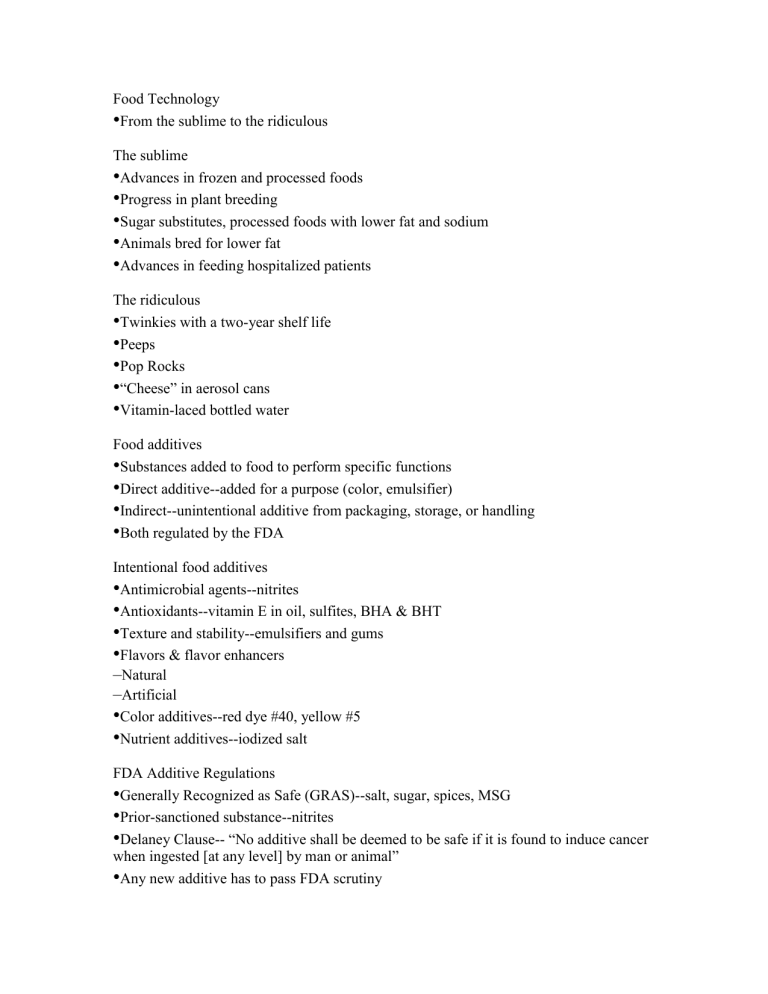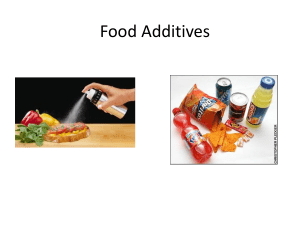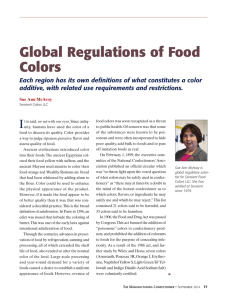Food Technology.doc

Food Technology
•
From the sublime to the ridiculous
The sublime
•
Advances in frozen and processed foods
•
Progress in plant breeding
•
Sugar substitutes, processed foods with lower fat and sodium
•
Animals bred for lower fat
•
Advances in feeding hospitalized patients
The ridiculous
•
Twinkies with a two-year shelf life
•
Peeps
•
Pop Rocks
•
“Cheese” in aerosol cans
•
Vitamin-laced bottled water
Food additives
•
Substances added to food to perform specific functions
•
Direct additive--added for a purpose (color, emulsifier)
•
Indirect--unintentional additive from packaging, storage, or handling
•
Both regulated by the FDA
Intentional food additives
•
Antimicrobial agents--nitrites
•
Antioxidants--vitamin E in oil, sulfites, BHA & BHT
•
Texture and stability--emulsifiers and gums
•
Flavors & flavor enhancers
–
Natural
–
Artificial
•
Color additives--red dye #40, yellow #5
•
Nutrient additives--iodized salt
FDA Additive Regulations
•
Generally Recognized as Safe (GRAS)--salt, sugar, spices, MSG
•
Prior-sanctioned substance--nitrites
•
Delaney Clause-- “No additive shall be deemed to be safe if it is found to induce cancer when ingested [at any level] by man or animal”
•
Any new additive has to pass FDA scrutiny
Unintentional Additives
•
Plasticizers in microwave packaging
•
Dioxins in coffee filters
•
Methylene chloride in decaf coffee
•
Hormones--recombinant bovine growth hormone
•
Antibiotics
•
Pesticides
Food Preservation Practices
•
Traditional--drying, fermentation, salting
•
Newer--canning, freezing, pasteurization
•
Irradiation--FDA approved to kill bacteria and insects in:
–
Spices
–
Fruits and vegetables
–
Poultry and red meats
Genetically Modified Foods
•
Humans have been doing this for ages; only the technology has changed
Traditional plant (or animal) breeding
•
Mate two different breeds with positive characteristics
•
Check the offspring for the desirable traits
•
This can be a long and cumbersome process
New-age plant (or animal) breeding
•
Insert gene of desirable characteristic (pest resistance, enzymes to make a nutrient) into genome of organism
•
Gene may be from same or different species
•
Quicker, but not foolproof
•
Inserted gene may be an allergen
•
European Union reluctant to adopt GM foods
Organic Foods
•
In 2000 USDA finally adopted labeling requirements for organic foods
•
Not necessarily safer than non-organic products
•
See next slide for details



